based on E.H. Nickel & M.C. Nichols (2009), H. Strunz & E.H. Nickel (2001)
revised by Thomas Witzke (2023)
5. CARBONATES
(Carbonates, Nitrates)
5.A: Carbonates without additional anions, without water
Zabuyelite: Li cations only in tetrahedral coordination.
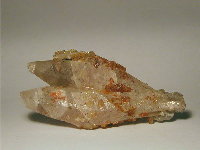 | 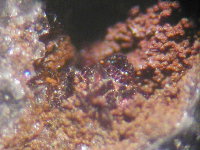 | 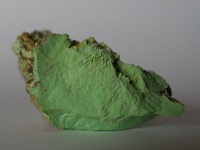 | 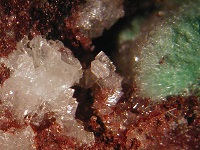 |
Calcite group: cations only in octahedral coordination. Increasing distortion of the octahedra with increasing cation size.
Dolomite group: cations only in octahedral coordination.
Isostructural with the borates of the Nordenskiöldine group.
Nahcolite: Na cations only in octahedral coordination. Nahcolite is isostructural with Sibirskite, CaH(BO3).
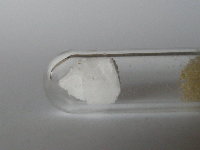 |  |  |  |
Eitelite: Mg cations in octahedral and Na cations in 6-fold, irregular coordination (Pabst, 1973, Am. Min. 58, 211-217).
Huntite: Mg cations in octahedral and Ca cations in 6-fold, trigonal prism coordination.
Norsethite: Mg cations in octahedral and Ba cations in 12-fold, hexagonal prism coordination.
Benstonite: Mg cations in octahedral, Ca in 8-fold, and Ba in 12-fold coordination (Effenberger, 1979, N. Jb. Min., Abh. 136, 326-337).
Sahamalite-(Ce): Mg cations in octahedral and REE cations in 9-fold coordination (Pertlik & Preisinger, 1983, Tscherm. Min. Petr. Mitt. 31, 39-46).
Natrite: corresponds to synthetic γ-Na2CO3 and forms an incommensurately modulated structure. There are 3 Na positions in the structure. The average structure can be described as graphite-like layers formed by Na(3) and CO3 ions, stacked along the c axis. Additional Na(1,2) cations are located in the pseudo-hexagonal channels, forming columns of somewhat distorted octahedra along [001]. The coordination can also be described as 4+2, where 4 distances are shorter than 2.3 Å, and 2 distances are about 2.4 Å. The columns are connected by CO3 triangles along [010] and [100]. Na(3) is in 8-fold coordination with oxygen in the range 2.35-2.9 Å. Natrite shows some structural relations to nahcolite (Akakcheeva et al, 2010, Am. Min. 95, 574-581).
BŁtschliite: Ca cations in octahedral and K cations in 9-fold coordination (Effenberger & Langhof, 1984, Acta Cryst., C40, 1299-1300).
Paratooite-(La): The ideal formula can be better given as (La,Sr,Ca)4CuCa(Na,Ca)2(CO3)8. Cu and Na(2) cations are in octahedral, Ca and Na(1) in 8-fold (distorted cubes) and La cations in 10-fold coordination. Paratooite-(La) can be described as a superstructure of carbocernaite (Krivovichev et al., 2019, Minerals 9, 370).
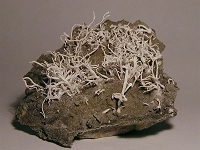 | 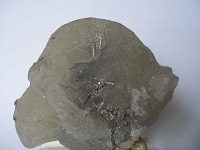 | 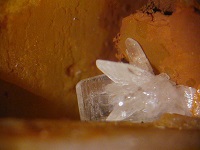 |  |
Kalicinite: K cations in 8-fold coordination.
Vaterite: Ca cations in 8-fold coordination.
Aragonite group: cations in 9-fold coordination.
Juangodoyite: Cu cations in planar 4-fold and Na cations 6-fold, trigonal prism coordination (Maslen et al., 1986, Acta Cryst. B42, 430-436).
Wegscheiderite: Na cations in 5-, 6- and 7-fold coordination (Fernandes et al., 1990, Acta Cryst. B46, 466-474).
Shortite: Na cations in 6- and 7-fold and Ca cations in 8-fold coordination.
Fairchildite: (K,Ca) cations in 7-fold and (Ca,K) cations in 8-fold coordination. Both positions show a mixed occupancy with K and Ca, with a preference of K for the 7-fold and Ca for the 8-fold coordinated position (Pertlik, 1981, Z. Krist. 157, 199-205).
Carbocernaite: (Ca,Na) cations in 7-fold and (Sr,REE) cations in 10-fold coordination.
Barytocalcite: Ca cations in 7-fold and Ba cations in 11-fold coordination.
Alstonite: Ca cations in 8-fold and Ba cations in 10-fold coordination.
Paralstonite: Ca cations in 8-fold and Ba cations in 10-fold coordination.
Burbankite: Na cations in 8-fold and Sr cations in 10-fold coordination.
Remondite: Na cations in 8-fold and REE cations in 10-fold coordination (Ginderow, 1989, Acta Cryst. C45, 185-187). Closely related to the burbankite group.
Teschemacherite: chains of [CO2(OH)]- in [001] direction. The chains are connected by [NH4]+ groups via hydrogen bonds (Pertlik, 1981, Tscherm. Min. Petr. Mitt. 29, 67-74).
Nyerereite: the mineral contains always significant amounts of K, the real composition is around Na1.64K0.36Ca(CO3)2. Natural Nyerereite shows an incommensurately modulated twin structure (Bolotina et al., 2017, Acta Cryst. B73, 276-284).
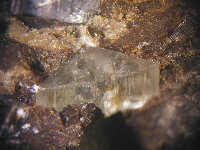 | 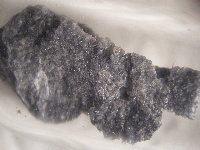 |  |  |
G = Grandfathered minerals: original description preceded the establishment of the CNMNC in 1959, and generally regarded as a valid species
A or IMA No. = Minerals approved by the CNMNC
Rd = Redefinition of the mineral approved by the CNMNC
Rn = Renamed with approval by the CNMNC
Q = Questionable mineral
Classification principles:
Subdivision of the Carbonates subclass "5.A: Carbonates without additional anions, without water" completely re-arranged compared to the chemical classification in Strunz 9. The subdivision is based now on structural aspects, the coordination polyhedra, corresponding roughly to the cation size (from smaller to larger cations): 5.AA. With cations only in tetrahedral coordination; 4.AB. With cations in tetrahedral + other coordination; 5.AC. With cations only in octahedral coordination; 5.AD. With cations in octahedral + other coordination; 5.AD. With cations in other coordination.
Further classification:
|
5.AA. With cations only in tetrahedral coordination: Only one mineral. 5.AB. With cations in tetrahedral + other coordination: No example known at time. 5.AC. With cations only in octahedral coordination: Mainly medium-sized cations in octahedral coordination; large cations in octahedral coordination. 5.AD. With cations in octahedral + other coordination: Medium-sized cations in octahedral + other cations in other coordination; large cations in octahedral + other cations in other coordination. 5.AE. With cations in other coordination: Single coordination type, arranged with increasing coordination number; more than one coordination type, arranged with increasing coordination number; other and unknown structures. |
To distinguish from classical Strunz numbering, on hierarchical "group" level, a numbering with 3 digits is used, like "5.AA.005. Zabuyelite", instead of 2 digits (like "5.AA.05.") in the Strunz system.
© Thomas Witzke (2023)
